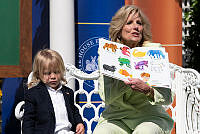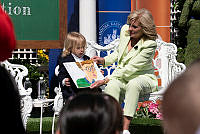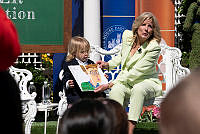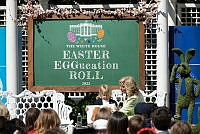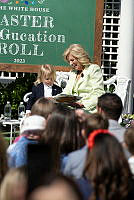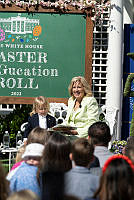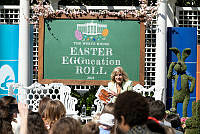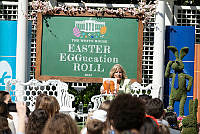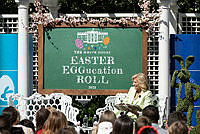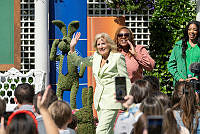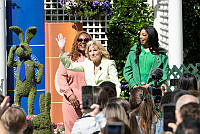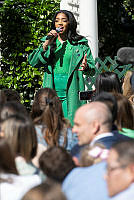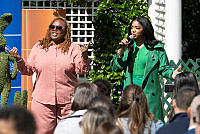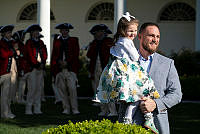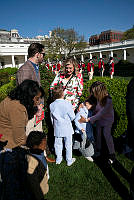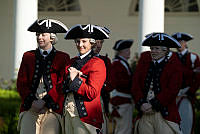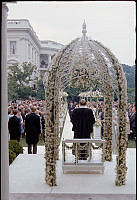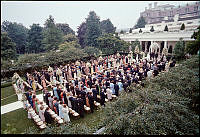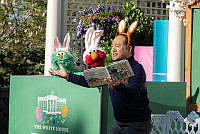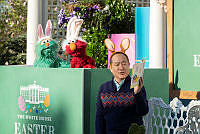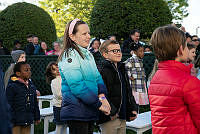Rubenstein Center Scholarship
White House Pigeons
As any visitor to Lafayette Square in Washington, D.C. will tell you, pigeons are a universal feature of the environmental landscape surrounding the White House. One reporter even designated the park across from the White House “almost as famous an abode for pigeons as St. Mark’s Square, Venice.” For many years, however, “carrier” pigeons transported messages for many miles, in some respects a more reliable mode of communication than the radio and wire technology of the early twentieth century. Though no longer required to carry word for miles above ground, pigeons have nevertheless made their impact known throughout White House history. This article explores several of these connections, ranging from the practical to the humorous.
During the summer of 1915, White House Police and other staff noticed three curious pigeons who continuously appeared on the North Lawn of the White House twice a day, once in the morning and again in the early afternoon. A likely reason for their returning is that the staff kept them well-fed with peanuts and other snacks. The Evening Star quoted one White House police officer who spoke in depth, remarking, “I have never seen pigeons quite like these . . . If they know a person well they will eat peanuts out of his hands.” He then continued to describe an amusing scene where the pigeons seemed to bathe under one of the sprinklers on the White House Grounds noting how “strangers passing through the grounds stopped near them and watched their antics. . . I never knew pigeons to do much bathing.”1

White House Police Officers feed pigeons.
Library of CongressIn July 1921, President Warren G. Harding and First Lady Florence Harding were aboard the presidential yacht Mayflower bound for Plymouth, Massachusetts where the president was scheduled to speak on the 300th anniversary of the Pilgrims’ landing. Before leaving Washington, Lieutenant A. J. McAtee, director of the naval pigeon service, brought several carrier pigeons for use aboard the yacht. On the afternoon of July 30, one of the pigeons returned to the Mayflower having updated the president’s staff at the White House in a message reading, “Fine voyage. All well. Mrs. Harding greatly refreshed. Making our schedule amid excellent conditions. Inspection this morning revealed fine crew . . . Greetings to all the office force.”2
In December 1923, First Lady Grace Coolidge released a pigeon from the White House Grounds for a mission to Cleveland, Ohio to deliver a message from the first lady to a poultry show convention. It was reported by the Cleveland Plain Dealer, “this novelty was arranged by pigeon fanciers of Cleveland. The birds were taken to the national capital by Messrs. J.C. Simons and Whittasack, both local pigeon breeders.”3
Tired carrier pigeons on missions elsewhere have also found refuge at the White House. In 1897, White House doorkeeper W. B. Lyda heard a pigeon cooing “in a pitiful way” and found the exhausted bird by an open White House window. There was no message attached. The only identifying item found on the bird was a steel band with the marking “F 27-5-30.” Unsure whose carrier pigeon it was, White House staff gave the lucky bird food, water, and comfort, until it was claimed.4

First Lady Grace Coolidge releases a pigeon in December, 1923.
Library of CongressIn the spring of 1931, the eaves of the North Portico had become home to a group of nesting, cooing pigeons drawn from Lafayette Square to the White House. They were attracted to the peanuts that were placed on the lawn. Intended for squirrels, the pigeons had relocated to the Executive Mansion’s grounds “to dip into the squirrel’s larder.” Though not necessarily intrusive, the birds were in the habit of cooing loudly when important guests and visitors were entering and leaving the White House from the North Portico. White House Grounds workers solved this issue by installing pasteboard in the eaves where the birds would normally land, thus moving the birds back across Pennsylvania Avenue to Lafayette Square or elsewhere.5
On November 29, 1938, a carrier pigeon arrived at the White House after a seventy-hour flight from Chicago to Washington to deliver a friendly greeting from Chicago mayor Edward J. Kelley to President Franklin D. Roosevelt in honor of the inauguration of the Baltimore & Ohio railroad’s stream-lined diesel engines on the Capitol Limited line. The pigeon had left Chicago but the weather soon turned to blizzard conditions. W. J. Firestein, who raised the pigeon and served as secretary of the Aero Racing Pigeon Club of Washington nearly gave up hope as he viewed the snow and ice accumulate outside his window. On the morning of November 26, however, the heroic pigeon appeared at Firestein’s home in Bladensburg, Maryland. Firestein could hardly believe his eyes and the pigeon was soon on his way to the White House to deliver the greeting to Press Secretary Stephen Early.6

Pigeons quench their thirst in a park in Washington, D.C.
Library of CongressAn observer in 1930 remarked, “The Lafayette Park pigeons have many friends, who bring them peanuts and other food they relish. They have no fear of man for only kindness is known to them.”7 The reputation of these pigeons in the Square became known throughout the Washington, D.C. area. In 1976, shoppers at the Rockville Mall Shopping Center, located in the Maryland suburbs, complained the pigeons nested and cooed too close for comfort. It was reported these suburban pigeons were quite unlike those near the White House who “graciously feed from the hands of people lunching outdoors.”8
Thus from messengers of presidential correspondence to observers of the arrival of important White House guests from perches above the North Door, it is likely the White House pigeons are here to stay.














